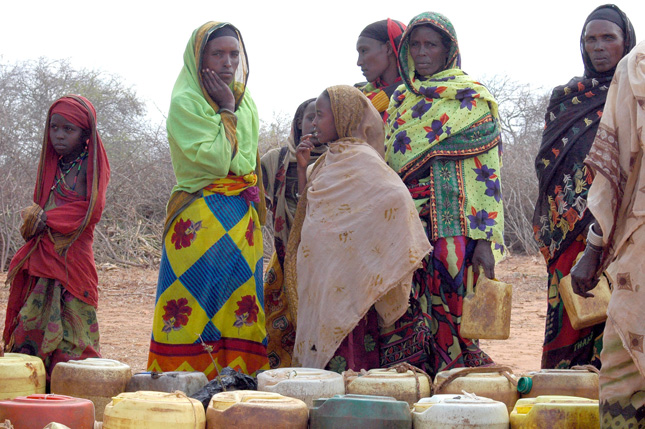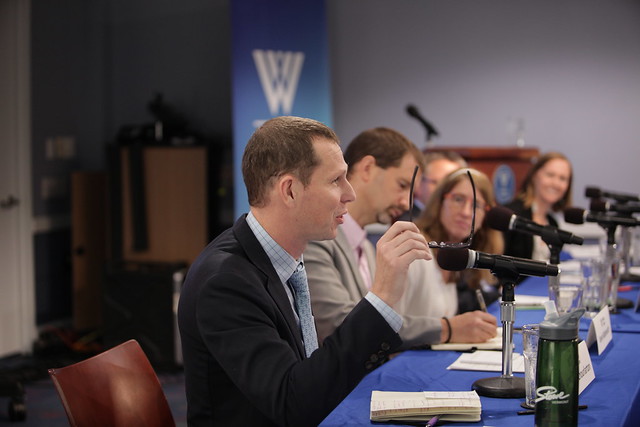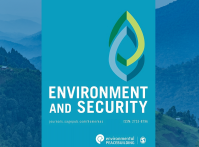-
Sustainable Water, Resilient Communities: The Challenge of Too Little Water
October 27, 2017 By Gretchen Johnson
Water is a “strategic instrument in the creation of a safer, healthier, more nutritious, less aggressive world,” said Winrock International President and CEO Rodney Ferguson at the first event in a four-part series on water security organized by the Wilson Center and the Sustainable Water Partnership. Panelists at the event identified innovative and integrated efforts necessary to increase global water security in the face of growing water scarcity.
Too Little Water
Water scarcity is not new, but the increasing number affected isWater scarcity is not new, but the increasing number of people that are affected is new: As many as two-thirds of world’s population experience extreme water scarcity for at least one month every year, said Richard Volk of USAID. If we continue our current consumption patterns, “the demand for fresh water could be as much as 40 percent greater than sustainable supply in just 12 years from now,” he said.
What drives demand? “Food security, energy security, economic growth, and even land use change: These are the non-climate drivers that water resource professionals cannot afford to ignore. And if you add climate change and variability to this mix of drivers, then we really are hard-pressed to think of a water-secure future that is not going to be increasingly difficult for us to achieve,” said Volk.
The consequences of water scarcity are borne most heavily by “most vulnerable, the poor, marginalized, women and children, and ecosystems, particularly the ecosystems where these vulnerable depend,” said Annette Huber-Lee of Stockholm Environment Institute. Water scarcity raises questions about competition: Who has the power, and how is water allocated?
Thirsty Food
Our agricultural systems account for 70 percent of the water we use. “The cup of coffee I had this morning took 140 liters to produce, a kilo of rice takes 3,500 liters of water to produce, and a kilo of beef takes 15,000 liters of water to produce,” said Richard Choularton of Tetra Tech.
To meet demand, “we need 70 percent more food by 2050,” said Choularton. “You can’t have food security without water security.” Water scarcity has long-term and wide-ranging effects on food supplies, leading to poor nutrition and poor health. Twenty percent of global undernutrition, or stunting, is related to environmental factors, particularly drought. “In Niger, if you’re born during a drought year, you’re 50 percent more likely to be stunted than if you’re born in a non-drought year.”
Drought-driven food insecurity can have global consequencesDrought-driven food insecurity can have global consequences. For example, the 2010 drought in Russia spurred wildfires that decimated wheat crops and led the Russian government to stop exporting wheat, said Kevin Rabinovitch of Mars Inc. The resulting spikes in food prices are considered one of the factors leading to the unrest during the Arab Spring. More recently, droughts in Syria, made worse by poor agriculture policies, drove farmers to migrate to the cities, where repression by the Assad regime inflamed grievances, starting a devastating civil war that continues today.
“We want to see these problems solved,” said Rabinovitch. Mars’ commitment–$1 billion for sustainability—is nothing to snicker at. Mars partners with the World Resources Institute and Pacific Institute to address sustainability through a science-based approach, including measuring its water use throughout the supply chain.
How do we produce more food amid growing water scarcity? “The best examples of sustainable improvements in food security are the places where there’s been sustained intervention in good watershed management, soil and water conservation, and changing that dynamic of land pressure, degradation, increased disaster risk, and low production,” said Choulartan.
Upstream Problems: Dumb Dams and Pollution Time Bombs
“The greatest decline in biodiversity around the world is in freshwater systems”Water pollution is a “time bomb,” said James Dalton of the International Union for Conservation of Nature (IUCN). IUCN’s assessment of the world’s 265 transboundary river basins found that river basin managers did not know enough about pollution, especially its impacts on food supplies and fish stocks. But we do know that pollution affects biodiversity. “The greatest decline in biodiversity around the world is in freshwater systems,” he said. “Because it is on our watch, we’ll be responsible for that.” Hydrodiplomacy needs to ensure that economic and social benefits of transboundary water resources are balanced with environmental and biodiversity benefits.
To meet the energy needs of our growing population, we are experiencing a global boom in dam construction, with 4,000 new high dams planned or under construction, said Volk. Dams can deprive ecosystems of natural flow and downstream users of essential fresh water, but they are also a relatively low-carbon source of energy. However, “smart” dams can be built using knowledge of river flows and sedimentation, and designed with flexibility that incorporates uncertainty, said Dalton. But these dams are only smart until someone downstream builds one that isn’t.
Sustaining Water, Sustaining Stakeholders
Media and governments “pay attention to floods and droughts because it hurts. And it hurts socially, it hurts economically, it hurts because you have to pay to rebuild, as well as fix the damage. And it also hurts because you have to re-plan about how you do it in the future,” said Dalton.
To get ahead of the hurt, engaging stakeholders is essential. The Stockholm Environment Institute holds workshops to engage competing stakeholders in a river basin. Before the workshops begin, the stakeholders rarely share a unified vision, but by the time they end, the participants have a better understanding of each other’s interests and the impact of their decisions on their neighbors, and thus are able to negotiate mutually beneficial steps.
We all have to share limited water supplies, so we must show how shared benefits can become regional and global benefits, said Dalton. Addressing water issues “requires a shared understanding of how we are all interconnected and interdependent,” said Huber-Lee.
Event Resources
Other articles in the Water Security for a Resilient World highlight the connections between water and food security; water as a tool for resilience in times of crisis; the importance of elevating women as water managers; enhancing water security and diplomacy in the Mara River Basin; using data to improve water security; the opportunity for innovative financing to expand access to water; the potential of innovative technologies for global water security; how citizen science can enhance water security; engaging communities to increase water point functionality; water and livelihoods in the Mara River Basin; the hidden forces of water in economic prosperity; and the challenges and opportunities of too much water, dirty water, and unpredictable water.
Sources: 2030 Water Resources Group, Food and Agriculture Organization of the United Nations, Mars Inc, Sustainable Water Partnership, Transboundary water Assessment Programme, United Nations Water, Winrock International, World Food Program, World Wildlife Fund
Photo Credit: Women queue for water near Moyale in the lowlands of Ethiopia’s Oromiya region, February 2006, courtesy of Flickr user Andrew Heavens
 A Publication of the Stimson Center.
A Publication of the Stimson Center.







